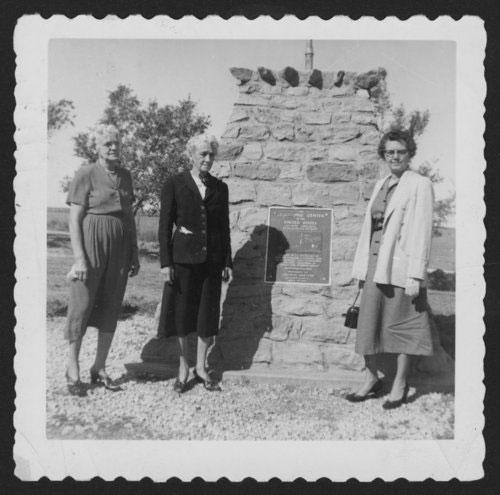
Smack-dab in the Middle
When the U.S. Coast and Geodetic Survey declared Lebanon to be the geographic center of the United States in 1891, it was cause to celebrate for the small town. However, the centrality of Lebanon would not go uncontested: Other Midwestern states were soon jostling for a slice of the fame. To meet the challenges of being at the nation’s geographic center, Lebanon created the “Hub Club” to maintain and promote the town’s designation. The Hub Club, in turn, helped the town to solidify its identity and to create a sense of solidarity and civic pride among its citizens.

A Contested Middle
In one tourist brochure from the 1950s, the Hub Club wrote, “Lebanon is a transportation ‘natural’ for industry, being centrally located, with two major highways leading to major markets in four directions.” In addition to the geographic center monument (erected by the Club), the brochure also promoted the town’s “progressive, growing, friendly community” and its location in “‘Home on the Range’ Country.” The Club notes that, in 1956, more than 18,000 people visited the monument of the geographic center, indicating the town’s successful marketing.
Even in the 19th and early 20th centuries, the Midwest was often considered something akin to that modern-day epithet “flyover country,” and states were eager to make a name for themselves. Consequently, Lebanon faced challenges from other cities and states, particularly Missouri, for claims of centrality. The Northwest Missouri Chamber of Commerce even promoted the region as the “Center of the World’s Breadbasket,” and there was a Missouri-wide effort to brand the state as the “Heart of America.” Meanwhile, Indiana put forth claims about being the population center of the United States.

The Expanding United States
Despite the challenges to its title, Lebanon held onto its claim to centrality. Headed by local business leaders, the Hub Club succeeded in having the geographic center site listed as a state historic site and gaining publicity from a number of state institutions, including a place on several official tourist maps.
The Hub Club also had to deal with the consequences of United States expansion. When Lebanon was declared the geographic center of the United States, there were only 48 states in the union. The addition of Alaska and Hawaii further complicated claims of centrality, but Lebanon solved that problem with a small amendment to its claim: it now distinguishes itself as the geographic center of the contiguous 48 states. “To our community, being at the center of the 48 states has brought many interesting visitors from a variety of countries and walks of life,” explains Linda Scott, project director for Crossroads in Lebanon. “We enjoy meeting and getting acquainted with visitors who come to visit the landmark, but it’s especially rewarding when they take the time to discover our way of life.”
A Community Achievement
Lebanon’s claim to celebrity might be humble, but it is the result of a concentrated community effort to promote the town and to establish a distinctive identity. Scott says the Hub Club is still active and meets to discuss ways to improve the community.
In 2007, locals banded together to form another group, the US Center Foundation, Inc. The group adopted the motto “Community Connection for a Proud Tomorrow.” Part of the Foundation’s mission focuses on revitalizing the town through volunteer-led efforts. These efforts demonstrate continuous local pride and camaraderie, and eventually lead to the revival of the annual Lebanon Bash, a popular daylong festival. Though being in the center of the U.S. might be an accident of geography, Lebanon succeeded in putting itself on the map through local efforts that had a statewide impact—and that was no accident.
Smack-dab in the Middle
The full exhibit is on display at Lebanon Community Library404 Main Street
Lebanon, Kansas 66952

 Get Directions
Get Directions Visit Website
Visit Website